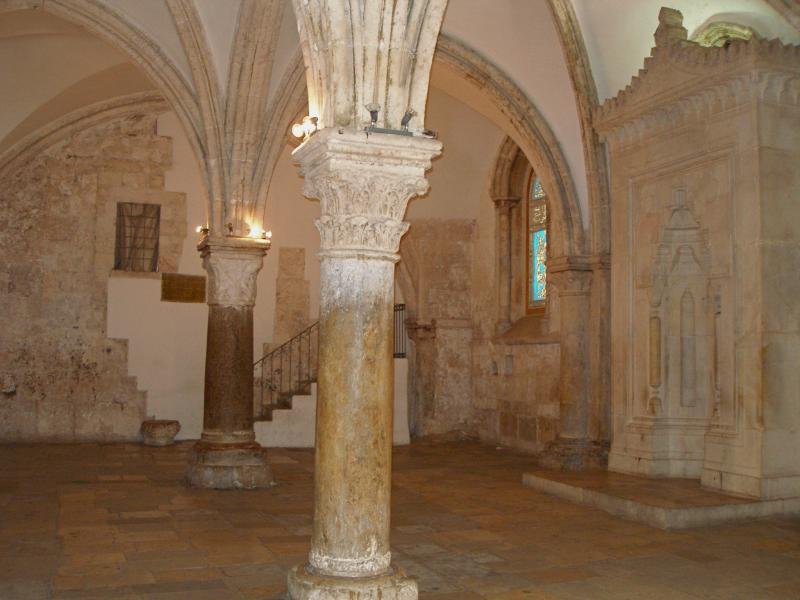The Power of the “Upper Room”
“You who dwell in the shelter of the most High, who abide in the shade of the Almighty, Say to the Lord, ‘My refuge and fortress, my God in whom I trust” (Psalm 91:1-2).
Cenacle (the Upper Room) on Mount Zion. Photo taken by Ranveig Thattai and used with permission under the Creative Commons Attribution-Share Alike 2.0 Generic license.
Growing up, I had a small sectionized prayer area in my room where I spent time with God before starting and closing off my day. Looking back, that area was my version of an “upper room.” As I grew older, however, the upper room became more of a spiritual metaphor to me rather than a literal place.
In the Bible, the events that occurred in the upper room are described in Matthew 26:1–29, Mark 14:12–25, Luke 22:7–20, and John 13:1–38. Christ knew that the time of his destiny was at hand and sought one last communion with his disciples first. He chose the place of this sacred communion, where he would share these most precious moments with his closest followers. He chose an upper room. Later, upon his return after his death and resurrection, he met with them once again in what we assume again to be an upper room. We then see this theme continued in the Book of Acts on the day of Pentecost, when the Holy Spirit came and dwelt among the disciples gathered and praying in an “upper room” (Acts 1:13, 2:1-13).
So, what’s the significance of the upper room? What was so special about it? Where can we find our own upper room? At church? At home? At work? Most importantly, what can we learn from life in the upper room?
The Role of the Upper Room
When we hear the phrase “upper room,” we might think of an attic storage space where we put all the stuff we don’t plan on using again but do not want to throw away. In the western world, the upper room is a rarely-visited place, essentially irrelevant to day-to-day life. However, in the first-century Holy Land, the upper room was the family room, an open-air social space on the roof where family and friends would gather at the end of a long day to tell stories, laugh at jokes, sip tea, and reflect on life.
It was this type of upper room that Christ used as his go-to gathering place with his disciples. Here, Christ washed his apostles’ feet and ate the final Passover meal. Even following his crucifixion and death, the resurrected Christ once again met with his disciples in the upper room. He elevated the upper room to an even higher level of importance than it already held. It became the place where he instituted the Eucharist and then the first place on earth where God the Father poured out his Holy Spirit.
Where Is Our Upper Room?
In the upper room, we gather to encounter Christ. More importantly, it is where Christ encounters us. From the moment we decide to be led by the Holy Spirit, the upper room is home. It becomes due north on our internal compass. In the upper room, we meet with God just as we are—no masks, no pretense, no posing. In the upper room, we experience firsthand the unconditional love of the Father.
What originally started as a physical space in Biblical accounts has now become a spiritual metaphor that beacons a significant spiritual reality. In today’s world, it is a place of personal communion with God, where the empowerment gained through our encounter with the Holy Spirit will transform all our imperfections and renew us. The upper room is where loving him becomes our main priority, hearing from him becomes our main focus, and serving him becomes our main desire.
With total trust, gratitude, and faith, enter your upper room, where Christ will fill you and equip you with the insight, wisdom, direction, boldness, confidence, and authority to be his witness at home, at work, and in the world. Go to your upper room, and don’t forget this valuable principle: It’s not the place but the presence that makes the upper room.
Shivonne Sant-Solomon is a wife and mother of two, blessed with the responsibility of raising them in this dynamic world! In all of her work, and in her most important roles as mother and wife, her relationship with God has been and continues to be central, as she is first and foremost a child of God. Over the past 19 years, Shivonne has had the opportunity to work in a variety of commercial roles within the energy industry, as well as assuming the role of a stay-at-home mother to her then-younger kids for three years—a transformational experience indeed, and one where the challenges and due respect are saluted and applauded. As Shivonne continues along her spiritual and professional growth and development paths, she seeks out opportunities to share her faith and contribute and support the achievement of the world’s energy transition goals in caring for God’s creation.


